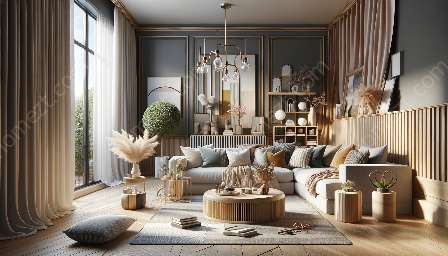Interior decor is more than just furniture and decorations; it's also about color. Utilizing complementary colors in your interior design can create a visually stunning space. This comprehensive guide will explore the impact of complementary colors, providing valuable insights into color schemes, palettes, and their compatibility with homemaking and interior decor.
Understanding Complementary Colors
Complementary colors are pairs of colors that are opposite each other on the color wheel. Examples of complementary color pairs include red and green, blue and orange, and yellow and purple. When used together, complementary colors create a dynamic and vibrant contrast, making them an excellent choice for creating focal points in interior spaces.
Impact of Complementary Colors
The use of complementary colors in interior decor can evoke various emotions and moods. For instance, pairing blue and orange can create a playful and energetic atmosphere, while red and green can evoke a sense of balance and harmony. Understanding the psychological effects of complementary colors is essential when selecting color schemes for different rooms in your home.
Harmonious Color Schemes
When incorporating complementary colors into your interior decor, it's crucial to consider the overall color scheme and palette. Utilizing complementary colors as accents within a predominantly neutral color scheme can create a striking visual impact. Additionally, experimenting with different shades and tones of complementary colors can add depth and dimension to your decor.
Exploring Color Schemes and Palettes
Color schemes and palettes play a significant role in interior decor. By understanding the principles of color theory, you can effectively utilize complementary colors within various color schemes. Whether you prefer a monochromatic, analogous, or triadic color scheme, integrating complementary colors can add a unique flair to your design aesthetic.
Monochromatic Color Scheme with Complementary Accents
In a monochromatic color scheme, which consists of varying shades of a single color, introducing complementary accents can elevate the visual interest of the space. For example, in a predominantly gray room, adding pops of vibrant yellow can create a striking contrast, making the decor more inviting and dynamic.
Analogous Color Scheme with Complementary Highlights
An analogous color scheme features colors that are adjacent to each other on the color wheel. By incorporating complementary colors as highlights within an analogous scheme, you can create a sophisticated and visually appealing interior decor. For instance, in a space dominated by shades of blue and green, adding touches of warm orange can introduce a sense of visual balance and excitement.
Triadic Color Scheme Enhanced by Complementary Tones
A triadic color scheme involves using three equidistant colors on the color wheel. By integrating complementary tones within a triadic color scheme, you can achieve a vibrant and balanced aesthetic. For example, combining the primary colors—red, yellow, and blue—along with their respective complementary hues can result in a lively and harmonious interior decor.
Enhancing Homemaking and Interior Decor
Embracing complementary colors in your interior decor can significantly enhance your homemaking experience. By carefully selecting and integrating complementary color combinations, you can create a space that reflects your personal style and enhances the overall ambiance of your home. Whether you aim to add drama, warmth, or tranquility to your living spaces, the thoughtful use of complementary colors can help you achieve your desired atmosphere.
Balancing Complementary Colors in Different Rooms
When incorporating complementary colors into different rooms, consider the unique function and mood of each space. For instance, in the living room, where relaxation and socializing are paramount, pairing complementary colors that exude warmth and comfort can create an inviting and cozy atmosphere. In contrast, a home office may benefit from complementary colors that promote focus and creativity, such as a combination of blue and orange for a balanced and stimulating environment.
Accessorizing with Complementary Colors
In addition to using complementary colors in wall paint, furniture, and textiles, you can also enhance your interior decor through carefully curated accessories. Incorporating complementary-colored accents, such as artwork, throw pillows, and decorative objects, can inject personality and cohesiveness into your decor, tying the color scheme together beautifully.
Experimenting with Complementary Color Pairs
As you delve into the world of complementary colors, you'll find endless possibilities for creating captivating interior decor. Whether you opt for bold and contrasting combinations or subtler harmonies, the key is to experiment and find the right balance that suits your taste and the ambiance you wish to achieve in your living spaces. By exploring various complementary color pairs and their applications, you can unleash your creativity and transform your home into a vibrant and visually captivating haven.


